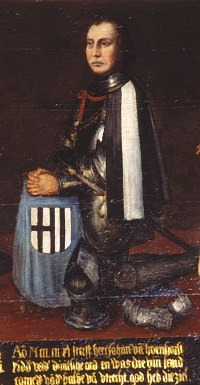Bailiwick of Utrecht
The Bailiwick cut its ties with the order based in the Holy Roman Empire and placed itself under the protection of the United Provinces of the Netherlands.
[2] The Teutonic Order was given property in the Netherlands in 1218–19 by Count Adolf von Berg and Sweder van Dingede.
[3] In the main Duitse Huis in addition to the knights and priests there were staff who assisted in church services and helped run the house and manage the bailiwick.
These included the treasurer, clerks, storekeeper and other administrative staff, as well as builders and craftsmen, and servants such as the baker, brewer, dishwasher and barber.
Amongst other, priest-brother Gerard of Vliederhoven wrote the influential Cordiale de quattuor novissimis whilst working in the Schoonhoven commandery.
[9] At the end of the fifteenth century, the Jüngere Hochmeisterchronik was written at the Duitse Huis, probably by the Utrecht land commander Johan van Drongelen with help by his personal secretary.
[10] The Bailiwick's expenses were covered by the return from assets, mostly farmland, which could not be alienated or encumbered without the assent of the general chapter of the order.
In 1520 there was a financial crisis when the general chapter demanded more money, and the land commanders of Utrecht, Alden Biezen, Westphalia and Lorraine jointly protested.
[2] In 1525 Albert of Brandenberg, grand master of the Teutonic Order, adopted Lutheranism and was made hereditary duke of Prussia by Sigismund I, king of Poland.
In 1545 the Emperor Charles V and his sister Mary of Hungary made the house their residence on the occasion of a meeting of the Order of the Golden Fleece.
In 1570 the administrator of the order's high master was housed there when he accompanied the Anne of Austria to Spain as bride of Philip II.
The Catholic land commander in 1579–1612, Jacob Taets van Amerongen, resisted on the basis that the goods "belonged to our Lord the German Master", and that the Bailiwick was a knightly institution that served "where necessary to fight with weapons for the defense of the Empire against our common arch enemy, the Turk..."[14] A struggle ensued with the States of Utrecht, which finally allowed the order to continue to exist on condition that they completely break with the Teutonic Order in Germany.
Assets could not be sold without the consent of the States and the order had to contribute to the costs of maintenance and preservation of the reformed worship.
Although forced to accept these terms, Taets van Amerongen was an ardent supporter of the Catholic faith and throughout his life considered that he was subordinate to the German master and the Archduke of Austria.
On 8 June 1615, when the chapter asked for permission to appoint a coadjutor, the States determined that offices, prebends and so on could only be given to followers of the reformed religion.
The general steward received a salary of 6% of total revenues, plus fixed fees for managing the finances and maintaining the house in Utrecht.
[2] The land commander, knights and staff remained at the Duitse Huis until 1807, when the property was sold to King Louis for 50,000 guilders.
[citation needed] The land commander Baron Bentinck asked the French for time to arrange for the settlement, and managed to greatly delay the process.
[2] A book published in 1812, slightly out of date, said the bailiwick of Utrecht still had ten commanderies: Dieren, Veluve, Tiel, Maasland, Rheenen, Leyden, Schoten,.Doesburg, Schelluinen, Middelburg and Schoonhoven.
[17] After the fall of Napoleon and the restoration of the House of Orange, on 8 August 1815 the Bailiwick was revived by royal decree of William I of the Netherlands.
In recent years this restriction has been relaxed, but members must still have four noble grandparents, and the families of the paternal and maternal lines must both date to before 1795.
[18] Today the order is engaged in charitable work, an echo of its original mission which also combined ministering to the sick with combating the infidel.

